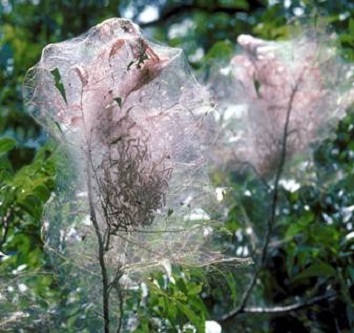That fake webbing that we like to adorn our trees and porches with for Halloween has a certain scary element to it but is not near as scary as the real thing!
Fall webworm (Hyphantria cunea) ‘nests’ often start becoming noticeable in our landscapes during the late summer to late fall. The caterpillars will spin their communal webs on the ends of branches on which they are feeding. They have been found on over 400 different species of trees and shrubs. In Texas, they are most commonly found on walnut, hickory, pecan, redbud, sweetgum, maple and oak. (Interestingly, they are not commonly found on pine trees or conifers.)

Fall webworms are known for their large webs on terminal foliage. Heavy infestations are rarely fatal to the tree itself, but if they occur over several years they can make trees more susceptible to drought, disease, or other insect pests.
Description
The fall webworm cycle starts as a Moth. It has a 1- to 1½-inch wingspan. Its wings are white but sometimes may have small, dark spots on the forewings. Full-grown larvae are approximately 1 inch long, pale green or yellow, and covered with tufts of long white and black hairs. Fall webworms often cover entire branches with their webs and in extreme infestations may cover the whole tree. Larvae feed within the web—they eat the tender parts of leaves but avoid the larger veins and midrib. Fall webworms overwinter as pupae on the ground, behind rough tree bark or in other sheltered sites around homes and buildings. Moths emerge from their silken cocoons in the spring, then disperse and mate. Female moths deposit hair-covered egg masses on the under sides of the leaves of their food plants. (Do not mistake these egg masses for those of the walnut caterpillar, which have no hairs.) Egg masses can contain up to 600 eggs. Each female moth deposits only one egg mass in her life. The larvae begin to build a silk web soon after hatching. As larvae consume leaves within the web, they expand the web to take in more foliage. Under ideal conditions, the life cycle from egg to adult is approximately 50 days.
Control
Fall webworms can be managed on smaller trees without insecticides. Physically removing the webs, caterpillars, or egg masses by knocking larvae out of low-hanging webs into a box or garbage bag with a stick or broom. You may also prune webs from lower and smaller branches by pulling them down with a rake or a pole.
Be sure to dispose of these away from your tree, and/or property and/or burn them. Don’t drag the webs across the lawn as they may fall out and re-infest a different area.
Fall webworms and their eggs are often eaten by beneficial such as birds, spiders, assassin bugs, parasitic wasps, and beneficial stinkbugs. You can help these beneficials by tearing open the protective webs.
If webs are too numerous or too high in a tree to deal with individually, you can use insecticides to prevent damage. Hose-end or commercial high-pressure sprayers are best for reaching upper parts of trees. Webworm larvae stay inside their web so insecticide sprays must penetrate the web to be most effective. For best control, apply insecticides when webs and caterpillars are small. Insecticides containing Bacillus thuringiensis (Bt) or spinosad are effective and will not harm beneficial insects.
Carbaryl and pyrethroid insecticides (such as permethrin, cyfluthrin, bifenthrin, and esfenvalerate) are highly effective against fall webworm. However, these insecticides are also toxic to our beneficial insects, so use them only for severe infestations.
Insecticidal soaps and horticultural oil sprays can also be effective when applied directly to caterpillars in their nests.
Insecticide labels are subject to change—always read and follow instructions on the pesticide label carefully. You are responsible for the effects of pesticides on your own property, as well as problems caused by drift to other properties. Not all insecticides are registered for fall webworms on all sites and commodities. Read the label to make sure the insecticide is labeled for your site and commodity.
For more information go online to Texas A&M Agrilife Extension Service.





